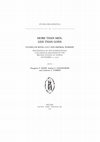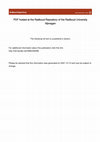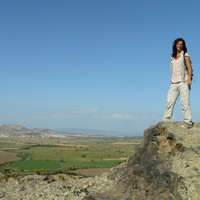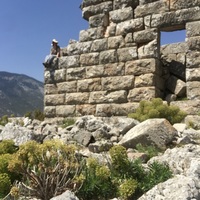Books by Panagiotis Iossif
Memory and Impression. Proceedings of the International Colloquium organized at Tegea - December 12-13, 2019, 2024
The Proceedings of the International Colloquium organized at Tegea, December 2019. Contains a ser... more The Proceedings of the International Colloquium organized at Tegea, December 2019. Contains a series of major contribution focusing mostly on the coinage of the region around Tegea and covers a large time span.
Meletemata, 2023
The volume includes eight studies focusing on the question of the payment of soldiers and mercena... more The volume includes eight studies focusing on the question of the payment of soldiers and mercenaries by the issuing authorities in Greek and Roman antiquity. The authors explore the use of coinage in relation to the salaries of the troops, but also in relation to the daily needs of the soldiers, both in peace- and war-time.
The second volume of the catalogue of the exhibition "Chaeronea, 2 August 338 BC: A day that chan... more The second volume of the catalogue of the exhibition "Chaeronea, 2 August 338 BC: A day that changed the world" with 19 essays on Chaeronea, the region, the battle, Thebes and Macedon and the aftermath of the Sacred Band.
With Ioannis Fappas.
Chaeronea, 2 August 338 BC: A day that changed the world, 2023
The bilingual (Greek-English) catalogue of the exhibition presenting more than 240 objects, most ... more The bilingual (Greek-English) catalogue of the exhibition presenting more than 240 objects, most of them unpublished and focusing on the decisive battle that opposed the Macedonian kingdom to the allied Greek cities under the leadership of Thebes and Athens.
Publication of the inaugural speech for the acceptance of the post of Professor of Numismatics at... more Publication of the inaugural speech for the acceptance of the post of Professor of Numismatics at the Radboud University Faculty of Arts, on Thursday 21 June 2018, Radboud University, Nijmegen
Greek Iconographies: Identities and Media in Context. Proceedings of a Seminar organised by the Netherlands Institute at Athens and the Belgian School at Athens.
Pharos, 2018
Proceedings of the International Conference organized by the Belgian and French Schools at Athens... more Proceedings of the International Conference organized by the Belgian and French Schools at Athens, 26-28 September 2012.

More Than Men, Less Than Gods is conceived as a demonstration project, with the goal of opening n... more More Than Men, Less Than Gods is conceived as a demonstration project, with the goal of opening new perspectives in the study of Graeco-Roman ruler worship. A principal emphasis is placed on the effectiveness of a multidisciplinary approach to the subject. The present volume points to some possible forerunners to Hellenistic royal cult and emperor worship, or at least to the concept of the divine king, to supplement the well-studied roots of ruler worship in the cultic life of the Greek polis and in pharaonic Egypt. More than Men... aspires to contribute to the debate relative to divine kingship, royal cult and emperor worship by opening new perspectives or reopening old ones. The focus is in eliciting some audacious and innovative approaches to such a complex phenomenon. All questions are not raised and certainly most of them are not answered here. In abandoning the sterile opposition between “political” and “religious,” the volume’s perspective transcends established notions conditioned by the Judeo-Christian model of western societies and scholarship, to consider the problem under different perspectives: there is no need to oppose “Greek” vs. “oriental,” “rational” vs. “emotional” to understand the birth of the phenomenon.
The diversity of approaches draws attention to the variety of sources that provide evidence relating to ruler worship, or that can enhance our understanding of the broader phenomenon of the divinization of powerful men. These include myth and historical accounts preserved by ancient authors; dedicatory inscriptions; clay tablets; papyri; architectural decoration and other archaeological remains; statuary, cameos, gems and various minor arts; seal impressions; and coins.
Catalogue of the exhibition of the same title organized at the Numismatic Museum Athens between S... more Catalogue of the exhibition of the same title organized at the Numismatic Museum Athens between September 29th, 2010-January 15th, 2011
Papers by Panagiotis Iossif
The Researches of Georgios Soteriadis at Chaeronea and the Excavation of the Tumulus of the Macedonians [in Greek]
Chaeronea, 2 August, 338 BC: A day that changed the world. The Essays, 2024
An extensive analysis of the role of Georgios Soteriadis, one of the pioneers of Greek archaeolog... more An extensive analysis of the role of Georgios Soteriadis, one of the pioneers of Greek archaeology, in discovering the Tumulus of the Macedonians at Chaeronea, as well as his extensive role as in charge of the researches in the area, where he was instrumental in building museums and organizing collections.
Chaeronea, 2 August, 338 BC: A day that changed the world. An Introduction
Chaeronea, 2 August, 338 BC: A day that changed the world, 2023
A detailed and up-to-date analysis of the data available on the battle of Chaeronea and on the la... more A detailed and up-to-date analysis of the data available on the battle of Chaeronea and on the large temporary exhibition organized at the Museum of Cycladic Art in 2023-2024.
ΤΥΠΟΙ Greek and Roman Coins Seen Through Their Images Noble Issuers, Humble Users? Proceedings of the International Conference Organized by the Belgian and French Schools at Athens, 26-28 September 2012, p. 269-295, 2018
Archaeological and Anthoropological Sciences, 2022
A quantitative analysis of the speed of diffusion of silver and bronze coins within the Seleucid ... more A quantitative analysis of the speed of diffusion of silver and bronze coins within the Seleucid empire through an innovative methodological approach.
Michael Alram, Jarosław Bodzek, Aleksander Bursche (eds), SURVEY OF NUMISMATIC RESEARCH 2014–2020, INC, Warsaw, 2022, 2022
Proceedings of the International Conference "A coin for the dead. Coins for the living. Charon’s obol: the end of a Myth?

Panayotis Iossif, Catharine Lorber, Laodikai and the goddess Nikephoros. Bronze coins of Antiocho... more Panayotis Iossif, Catharine Lorber, Laodikai and the goddess Nikephoros. Bronze coins of Antiochos IV shows a goddess Nicephorus who shares in the king's epiphany. She is a rare form of Aphrodite, previously associated in the deification of two Hellenistic queens, including the Seleukid Stratonike. The older cult of Aphrodite Nikephoros at Argos characterized her as a matrimonial deity. Her presence on coins or seals of scattered Seleukid cities suggests the establishment of a state cult for a female relation of Antiochos IV, either his wife, Laodike IV, or his mother, Laodike III. The former was the first Seleukid queen portrayed on coinage ; the visual evidence supports the theory that she was the daughter of Antiochos III and married her three brothers in succession. Laodike III had already been the object of an ephemeral (?) state cult ordained by Antiochos III and was worshipped as Aphrodite Laodike in a city cult of lasos. In the east, the Nikephoros was probably understoo...
Οι αρχαιολογικές έρευνες της Βελγικής Σχολής στον Θορικό (2010-2015)
Antiochos III du Louvre" et le "souverain des Thermes" : quelques réflexions sur le portrait royal hellénistique et le portrait tardo-républicain
La tete du Louvre (MA 1204) avec diademe attribue longtemps a Antiochos III doit plutot represent... more La tete du Louvre (MA 1204) avec diademe attribue longtemps a Antiochos III doit plutot representer Jules Cesar, mais d'un type inconnu jusque la (plis du cou caracteristiques). Une grande statue en bronze appelee Souverain des Thermes et de provenance inconnue mais sans doute orientale ne porte aucun diademe mais pourrait plutot que de presenter un personnage romain republicain figurer un souverain hellenistique a forte personnalite et voulant se demarquer de la dynastie a laquelle il appartient : Demetrius I Soter











Uploads
Books by Panagiotis Iossif
With Ioannis Fappas.
The diversity of approaches draws attention to the variety of sources that provide evidence relating to ruler worship, or that can enhance our understanding of the broader phenomenon of the divinization of powerful men. These include myth and historical accounts preserved by ancient authors; dedicatory inscriptions; clay tablets; papyri; architectural decoration and other archaeological remains; statuary, cameos, gems and various minor arts; seal impressions; and coins.
Papers by Panagiotis Iossif
With Ioannis Fappas.
The diversity of approaches draws attention to the variety of sources that provide evidence relating to ruler worship, or that can enhance our understanding of the broader phenomenon of the divinization of powerful men. These include myth and historical accounts preserved by ancient authors; dedicatory inscriptions; clay tablets; papyri; architectural decoration and other archaeological remains; statuary, cameos, gems and various minor arts; seal impressions; and coins.
This article explores the numismatic production of Alexander II Zabinas in Damascus through a corpus and a die study of the material. The long catalogue is followed by a detailed metrological, quantitative, and historical analysis. The dated tetradrachms and drachms produced in the Syrian mint offer an interesting perspective on the historical circumstances which allowed Alexander II to conquer Damascus, to replace the previous mint administration under Demetrius II, and to prepare his fatal campaign against the alliance lead by the future Antiochus VIII.
levels. His administrative reforms were recently thoroughly examined by John Ma and Laurent
Capdetrey (among others). In these studies, the focus is on epigraphic and literary sources. Hence,
numismatic evidence occupies a rather marginal part on the analysis of this major reign for the
formation of the Hellenistic world and the involvement of Rome in eastern Mediterranean. This choice
can be explained by the fact that both Ma and Capdetrey mostly consider the western and highly
urbanized areas of the kingdom. Nevertheless, when it comes to study the Oriental aspects of
Antiochos’ policy, epigraphy and literary sources are defaulting; coins are by far our most numerous
primary sources (not to say the only primary sources) when dealing with the Great King’s eastern
policy. The comprehensive catalogue of Seleucid coins by Arthur Houghton and Catharine Lorber
(hereafter: SC) offer the basis for every numismatic research. The last couple of years, using SC as
starting point, I gathered the two largest numismatic databases of the Greek world: a. the “Seleucid
Hoard Database” (SED) where are gathered more than 12,300 Seleucid coins found in hoards
throughout the Hellenistic world (mostly tetradrachms), and b. the “Seleucid Excavation Database”
(SHD) collecting more than 8,300 coins (mostly bronzes) from more than 80 sites. The two databases
will allow me to survey the monetization of the eastern part of the kingdom (as opposed to the western
part), examine different ad hoc monetary policies of the king following his eastern military campaigns,
estimate the speed of coin circulation, and try to understand the phenomenon of Antiochos’ temporary
military mints against the general pattern of his eastern numismatic policy. One of the questions that
will be asked is the following: which of these mints became permanent forming therefore parts of new
military installations?
From the analysis of coin distribution (based on SHD and SED), I will tend to observe which
areas received military installations and which regions remained ‘coin-free’ zones both in terms of
production and circulation. More questions will consider the importance of mint (and coin) distribution:
does the absence of coinage in certain areas (mostly in eastern Iran) mean absence of military colonies?
Alternatively, did these soldiers receive land grants following, in a certain sense, a Ptolemaic-inspired
policy?
In order to better understand the (numismatic and economic) policy of Antiochos III, it is
necessary to question the role of the so-called eastern capital as a major mint, i.e. Seleucia on the
Tigris. In that respect, I will examine in profundis how the mint worked, estimate its numismatic
output, designate areas of diffusion of the local production, and try to estimate its economic (and
institutional) importance in the general eastern policy of Antiochos III.
Focusing on test cases from the Seleucids (Syrian Wars, loss of large territories, post-Peace of Apamea period) and the Ptolemies (again, Syrian Wars, local revolts in Upper Egypt, etc.), I will try to define the general patterns adopted by the two Hellenistic dynasties when facing important crises. Three extensive databases will be used for such analysis: the “Seleucid Hoard Database” (SHD) and the “Seleucid Excavation Database” (SED) compiled by Iossif and the large die study for the second part of the Ptolemaic dynasty by Julien Olivier. Also, data from prices will also be considered in relation to the rich documentation from Babylonian cuneiform tablets.
The methods used by the Seleucids were conservative and innovative at the same time. It was conservative because all of them were coming from the religious “tool kits” of traditional gods; innovative because of the ingenious combination of different traditions attesting a conscious marketing policy targeting different audiences through different media. In the present analyses, I will try to explore the techniques used by Seleucos I and his successors for creating their royal charisma against the background of Greek religion, local millennial traditions, and how the figure of the Seleucid king influenced the figures of the ruler in the Middle East through the next centuries. I will argue that the figure of the king, deified in the most “discreet” of ways, was the central, if not the only, element creating a notion of appartenance à la nation necessary for the formation of a large kingdom.
These self-evident points are regularly asked when studying Roman coinages, especially in the West , but are rarely considered in studying the Greek numismatic material from excavations, even if considerable progress have been done in the last two decades. Even in the cases where excavation coins are used for the long term, the relevance of this material as a statistically reliable sample is virtually never considered. In this article, I will try to consider a statistical and quantitative approach based on the Seleucid numismatic material coming from 80 excavations/sites in Asia Minor, the Near and Middle East, the so-called “Seleucid Excavations Database” or SED. Since the focus of this analysis is methodological, and in what follows, I will consider the possibilities offered by such an approach without providing too many answers. In the following section, I will explain the formation of the SED, its nature, and characteristics. Section 3 will deal with the reliability of the database measuring a comparison with large numismatic collections. Section 4 will consider the questions of the influence of denomination (and module) in coin loss patterns and the coin production will be considered in time (by reign) and space. The final section will deal with one particular aspect of the potential offered by this analysis: the examination of the speed of circulation of Seleucid coins within the borders of the Empire; I will conclude with some additional thoughts and possibilities offered by this type of approach.
panthéa « iconographiques », qui se forment par les monnaies et les empreintes de sceaux. La ville
fut l’atelier le plus prolifique de la première période de la vie de la dynastie séleucide et, en même
temps un centre administratif majeur, dont les Archives ont été mises au jour lors des fouilles
américaines et italiennes menées sur le site.
La présente étude testera la pertinence d’un modèle méthodologique populaire, qui se base sur
l’étude des images monétaires et en glyptique pour tirer des conclusions sur les pratiques
religieuses, les dieux honorés et les rapports entre le divin, le royal et le civique. Les données qui
proviennent de la production monétaire de la cité mésopotamienne, de même que les très
nombreuses empreintes de sceaux des Archives de la ville, offrent les conditions optimales pour
cette étude.
Dans le cadre de cette présentation, on propose une analyse des aspects religieux qui
accompagnent ces deux types de média de l’image royal et divine. La nature de la documentation
disponible permet à l’étudiant de la religion grecque et de l’iconographie un instantané presque
unique sur la vie religieuse, royale et civique de la cité pour une période de près d’un siècle.
Les monnaies, souvent considérées comme les véhicules de la politique royale par excellence,
créent un certain type de panthéon royal (où le personnage du roi est à inclure). Les sceaux, de
l’autre côté, ayant une finalité et fonction différentes dans le fonctionnement de la ville et du
royaume par rapport aux monnaies, portent des images divines et royales et forment un panthéon
précis. La comparaison entre les deux panthéa formés par les deux types de média nous
permettra de tirer des conclusions sur toute une série d’aspects :
- La religion officielle/royale vs. la religion civique ;
- Les transferts de types iconographiques d’un médium à l’autre ;
- Les divergences observées entre les deux panthéa ;
- Les raisons des transferts et/ou des divergences ;
- Les publics visés par les deux panthéa.
En dernier lieu, cette analyse, tout en s’y inscrivant dans la récente étude de Michael Squire
(2009), se présentera comme un modèle méthodologique visant à déterminer les limites de
l’apport iconographique dans l’étude de la religion, de la position du roi, des religions civiques
etc. Pour éviter les excès de surinterprétation d’une image (isolée ou faisant partie d’une large
série), il est nécessaire de prendre en considération : la nature du médium et tant que tel, son
contexte, ses rapports avec les autres média.
Outre les appels évidents à la numismatique, la sigillographie, l’épigraphie, la grande sculpture ou
l’histoire des religions, cette étude utilisera de manière extensive la statistique pour appuyer ses
résultats.
""
These inscriptions, with the exception of the prostagmata of 209 for the nomination of Nikanor and 193 for the grand-priestesses of the cult of Laodike, are most likely reflecting the point of view of the city and her own anxieties to deal with an unknown power. The same inscriptions are not dealing with the question of the status of the Seleucid king: divine? hero? human? Furthermore, they provide no evidence on the way kings (and their courts) considered themselves. Lacking any other evidence, the more obvious way to understand how the Seleucids considered their own status is through coinage and divine epikleses.
The present lecture will propose a reading of images on coins based on the criterion of the status of the Seleucid kings. The approach intend to be methodological (how to read images on coins in the particular framework of divinization of the king and how to compare these images with official epithets) and demonstrative (study cases that will illustrate the purpose). In summary, we will try a different reading of the “royal cult” of the Seleucids by extending the evidence and changing perspective: images will be central in this reading and we will follow the up-to-bottom approach from the king to his subjects. A different image of the divinity of the Seleucid king will come out, one that challenges established approaches. In the very end, what we will try to answer is the following: “did a royal cult of the Seleucids really existed”?
Thanks to new methods of investigation, the field of funerary archaeology has developed in the last years. Fine excavation, precise archiving of contextual data and the many pluri-discinplinary studies have led to the establishment of an “archaeology of ritual”. Far from the simple gathering of material that excavating burials was confined to, this discipline now takes into account two essential things: biological anthropology and the study of taphonomic phenomena. The objects that were deposited in the tombs are then considered as part of the context in which the deceased is placed: in other words they can inform us on the funerary gestures.
Although the study of rites and gestures seems like an innovating field in archaeology, the taking into account of the data from the analysis of coins from funerary contexts has not yet followed this trend, despite the fact that this theme is undoubtedly at the heart of the renewal of funerary archaeology. The gesture of depositing one or more coins is indeed part of complex and various ritual sequences whose aim is the constitution of a tomb. Since the conferences held at Salerna (“Caronte. Un obolo per l’Aldila”, 20-22 Februrary 1995) and at Neuchatel (“Trouvailles monétaires de tombes”, 3-4 March 1995), which were thought of as pioneers on this matter, no new summary has been attempted on this practice nor on the integration of numismatic data within the funerary archaeology speech itself.
The aim of this conference is to revisit the question of monetary discoveries within burials through a contextual approach, incited by conceptual progress in the analysis of funerary documentation that has been made in the last years. This strictly anthropological approach aims at establishing a dialectical relationship between the facts that are precisely documented and their integration into a theoretical framework.
In this prospect, we would like to organize the days of the conference around central questions of material aspects of the practice, of their place within ritual sequences and their evolution in a longer timeframe. The ambition of this conference is to confront the state of our knowledge, methods and case studies in the Mediterranean between the 5th cent. B.C. and the 7th cent. A.D.
This meeting will be an opportunity for addressing questions that are common to archaeologists and numismatists as far as the protocol of the study of coins in funerary contexts is concerned. An important place will therefore be devoted to the recent data and to the innovating methods of approach.
The geographical and chronological frames that have been set will allow us to have an overview of local particularities and chronological evolutions as well as shed light on new lines of approach on the practice (specific observations, specific studies, possible correlations…).
The accent will be on transdisciplinary approaches and on excavations with precise documentation, which are the only ones capable of rendering the contexts in which these gestures take place.
Proposals for papers (title and abstracts of ca. 20 lines) or for posters (A0 format required) are expected by April 30, 2017.
Contact address: piossif@ebsa.info
The selection comity will meet at the beginning of May 2017.
The length of each paper will be 30 minutes maximum (+15 minutes for discussion)
Definitive texts will have to be submitted within one month after the conference for publication in a special issue of the Journal of Archaeological Numismatics (JAN 2019/9), to be released in May/June 2019.